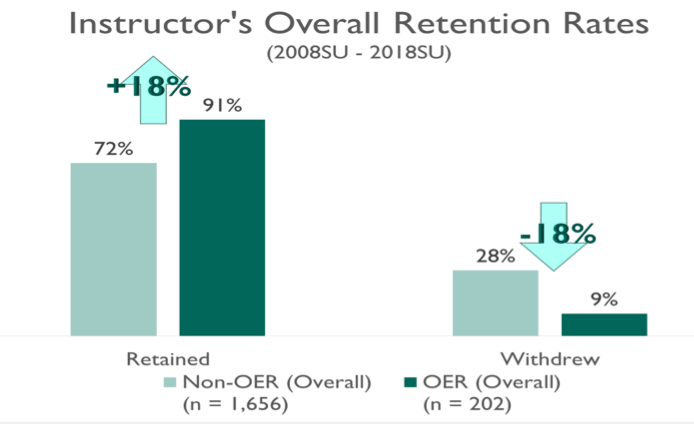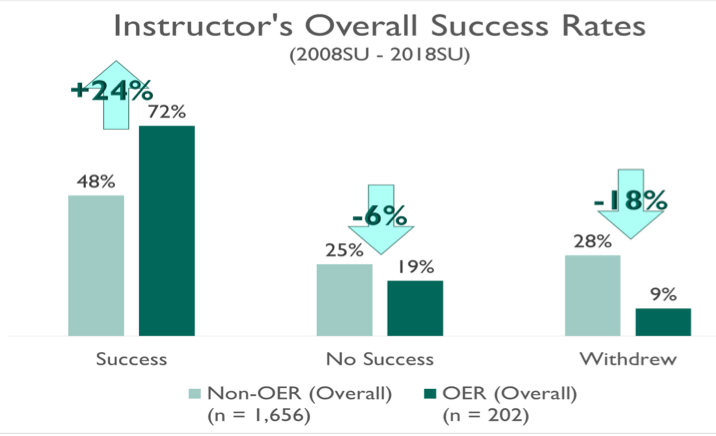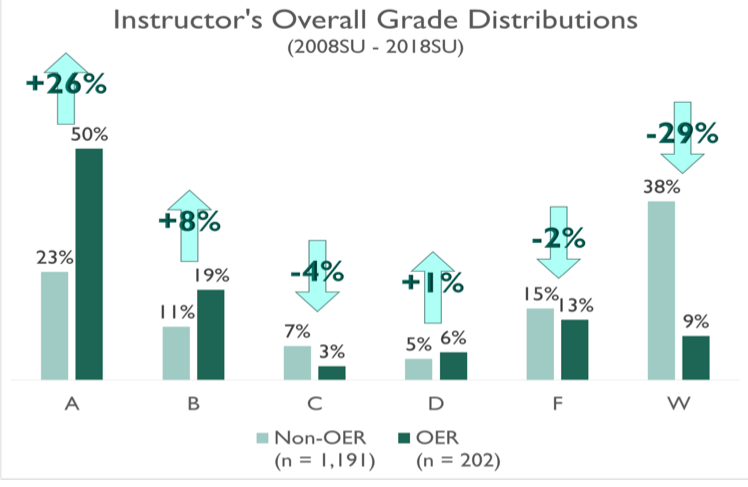Authorship in the Age of OER
I am a counselor at Grossmont College in San Diego. As part of my role, I teach a course in Study Skills and Time Management. In an effort to support my students, I applied for sabbatical leave in the Fall 2018 semester to curate three OER (Open Educational Resources) for my course and to be shared amongst common College Success classes at Grossmont College. This post will provide an overview of how I produced my OERs and showcase some exciting data about the impact OERs have had on my students’ success and retention.
Writing With a Little Help From My Friends
To start with my OER development process, I researched existing high-quality College Success OERs shared with Creative Commons-Attribution (CC-BY) open licensing and used Pressbooks to “reuse” and “remix” some of the existing content and integrate my own original content. Then members of the Rebus Community conducted a blind peer review of my work – and I held my breath.
With some terrific constructive criticism and suggestions from the reviewers, I edited, edited, and edited some more. The OER text also went through an accessibility review (thanks Will Pines!) and a student review. Thanks to folks at Pressbooks and the Rebus Community, I am proud of the resulting three Blueprint for Success in College OER textbooks being used for College Success and Personal Growth courses, orientations, and first year experience programs (officially published by the Rebus Community, 2018):
- Blueprint for Success in College and Career
- Blueprint for Success: Indispensable Study Skills and Time Management Strategies
- Blueprint for Success in Career Decision Making
The Student Experience
These openly licensed OER textbooks are FREE to students digitally. Many studies have found that college students (especially community college students) do not purchase textbooks because of their cost. Therefore, having access to high quality, openly licensed, and free textbooks on day one of a course is helpful for many students.
Digital OER textbooks also provide students with many access options. OER designed with Pressbooks are accessible on smartphones, tablets, laptops, desktops, Kindles, and Nooks. Students may also download the texts so they can access them offline, which is especially useful for students in rural areas. These options allow students to have the learning material on (or before) the first day of classes and also ensures their access does not expire after the course ends. This can be helpful for students who are taking courses in a sequence, repeating courses, or studying for post class or graduate exams. There is no need to purchase an access code again.
For students who prefer to have a print copy of the text, lulu.com provides high quality print versions at a low cost (only the cost of printing and paper) with no royalties and no tax that students have to pay for. The 456-page Blueprint for Success in College and Career OER textbook would cost a student just $8.45 via lulu.com (black and white) plus $3.99 for shipping.
Here are a few quotes from my students:
“I learned so much from the book that I now use it on a daily basis. I even help my little sister by telling her all these lessons. It just has so much goodness jam packed into it.” - Jasmine Pineda
“I love the free, accessible textbook. Thank you so much for that.” - Margaret Yakou
“My favorite part of the class would have to be reading the book. There was an abundant amount of helpful information that taught me many new perspectives and ideas.” - Bladimir Enriquez
Measuring the Impact
Although the three Blueprint OER texts I produced were only released a few months ago and there has been no organized effort to market them, they are spreading around the California Community Colleges by word of mouth. At least one instructor from each of the following nine colleges is using one of the Blueprint texts (or an adaptation of one of them): Grossmont, Hancock, San Diego City, Mesa, Miramar, Pasadena City, Reedley, Saddleback, West Hills Lemoore. In addition, the texts are also being used in Oregon, New Jersey, and New Hampshire.
During my sabbatical, I was also eager to analyze how using OER in my teaching was impacting student success and retention. I started teaching with OER in the Spring of 2018 and I noticed almost immediately that students were more engaged. With assistance from our local Institutional Research (thanks Stacy Teeters!) we were able to collect data from every course I taught at Grossmont over the last 10 years and compare the courses in which I used commercial textbooks that students had to purchase with the four sections I taught with OER in the Spring and Summer of 2018. The data, as they say, doesn’t lie.
Although not statistically significant, the data illustrated in the charts above is consistent with a larger study recently conducted at the University of Georgia. I have been teaching online recently as my children are young and I appreciate the convenience it gives me. As the success, retention, and grade distribution are exceeding some face-to-face numbers, I would call this a victory for both OER and online teaching.
What’s Ahead
Although the Blueprint College Success OER texts continue to be a work in progress, there are ancillaries in development that may make the content even more engaging to students and give faculty options and incentives to adopt OER. Currently, we are working on an audio version of the texts that students will be able to listen to, a cultural competency/global awareness chapter, and we’re planning a Spanish version.
If you would like more information and/or are interested in collaborating on any of these projects:
- Leave a comment below or contact me via email or Twitter.
- View the archive of my recent Academic Senate for the California Community Colleges (ASCCC) College Success OER webinar.



